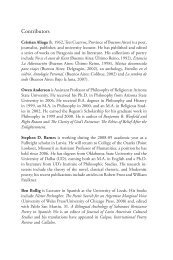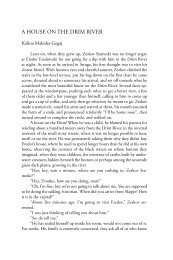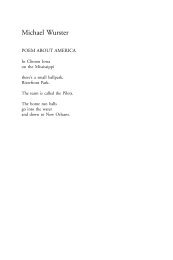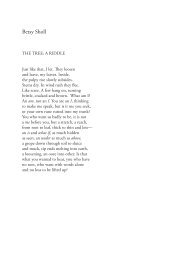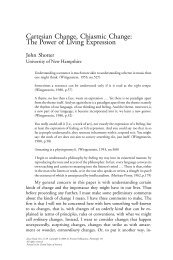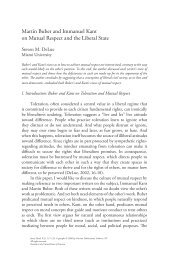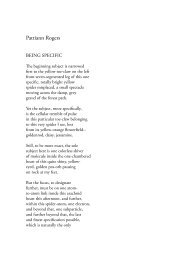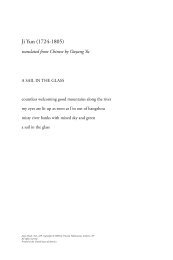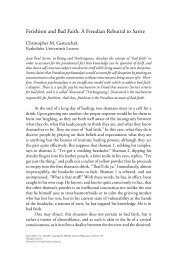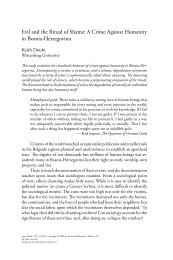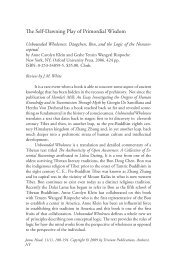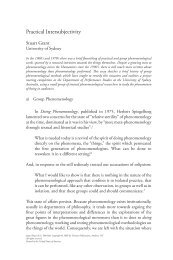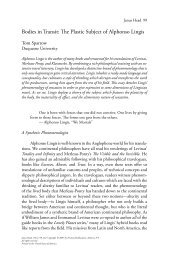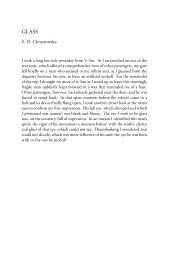Hesse's Steppenwolf: A Comic-Psychological ... - Janus Head
Hesse's Steppenwolf: A Comic-Psychological ... - Janus Head
Hesse's Steppenwolf: A Comic-Psychological ... - Janus Head
You also want an ePaper? Increase the reach of your titles
YUMPU automatically turns print PDFs into web optimized ePapers that Google loves.
128 <strong>Janus</strong> <strong>Head</strong><br />
<strong>Steppenwolf</strong>,” a copy of which Haller has included in his manuscript. In<br />
Ziolkowski’s analysis, these three subdivisions correspond to “the classical<br />
structure for the opening section of a sonata” (1965, p. 189). Two themes,<br />
that of the <strong>Steppenwolf</strong> and the burger--the two parts of Haller’s soul--are<br />
introduced in the first division. In the following subsection these themes are<br />
developed and interpreted in terms of their significance in Haller’s life. �e<br />
third subsection recapitulates the two themes and proposes their resolution.<br />
�us <strong>Steppenwolf</strong>’s first movement follows sonata form: two themes are set<br />
forth, developed, and then restated.<br />
�e second movement contains the novel’s action which takes place<br />
during a several week period leading up to and including the masked ball.<br />
�is is the time during which Haller is instructed by Hermine. In this second<br />
movement the themes from the first division are further developed through<br />
what Ziolkowski describes as the literary equivalent of the musical device<br />
of counterpoint: double perception (1965, pp. 195-199). Double perception<br />
is a technique employed by Hesse in order to render the simultaneous<br />
existence of two levels of reality. Double perception, like counterpoint<br />
which, according to the Howard Dictionary of Music combines “into a<br />
single musical fabric” lines which have “distinctive melodic significance,”<br />
(quoted in Ziolkowski, 1965, p. 198) brings the real and the imaginal into<br />
play at the same time. �e net result of this double vision in <strong>Steppenwolf</strong><br />
is the collapse of dichotomies: flesh/spirit, real/unreal, and subject/object.<br />
Double perception communicates Hesse’s conception of magical thinking<br />
as the free exchange of inner and outer realities and the perception of their<br />
essential unity. �e fantastic events around which all of the novel’s action<br />
revolves—attaining the Treatise, the relationship with Hermine, the Magic<br />
�eatre, etc.—each rely in one way or another, on magical thinking.<br />
�e Magic �eatre is the <strong>Steppenwolf</strong> sonata’s third and final movement.<br />
Ziolkowski refers to this movement as a “theme with variations,”<br />
and as the work’s “finale” (1965, pp. 216, 224). Here Hesse explores the<br />
multiplicity of personality, one of <strong>Steppenwolf</strong>’s central themes, by composing<br />
variations on motifs already present in the previous two sections. �e<br />
succession of fantasies experienced by Haller in the Magic �eatre is episodic<br />
amplifications of chords struck during the course of Haller’s re-education.<br />
�e novel reaches its finale in a waking dream in which the <strong>Steppenwolf</strong><br />
understands the significance of the initiation he has undergone.




